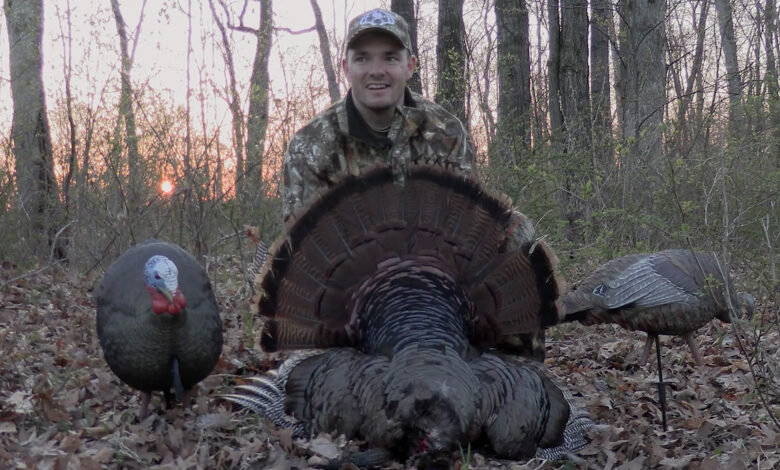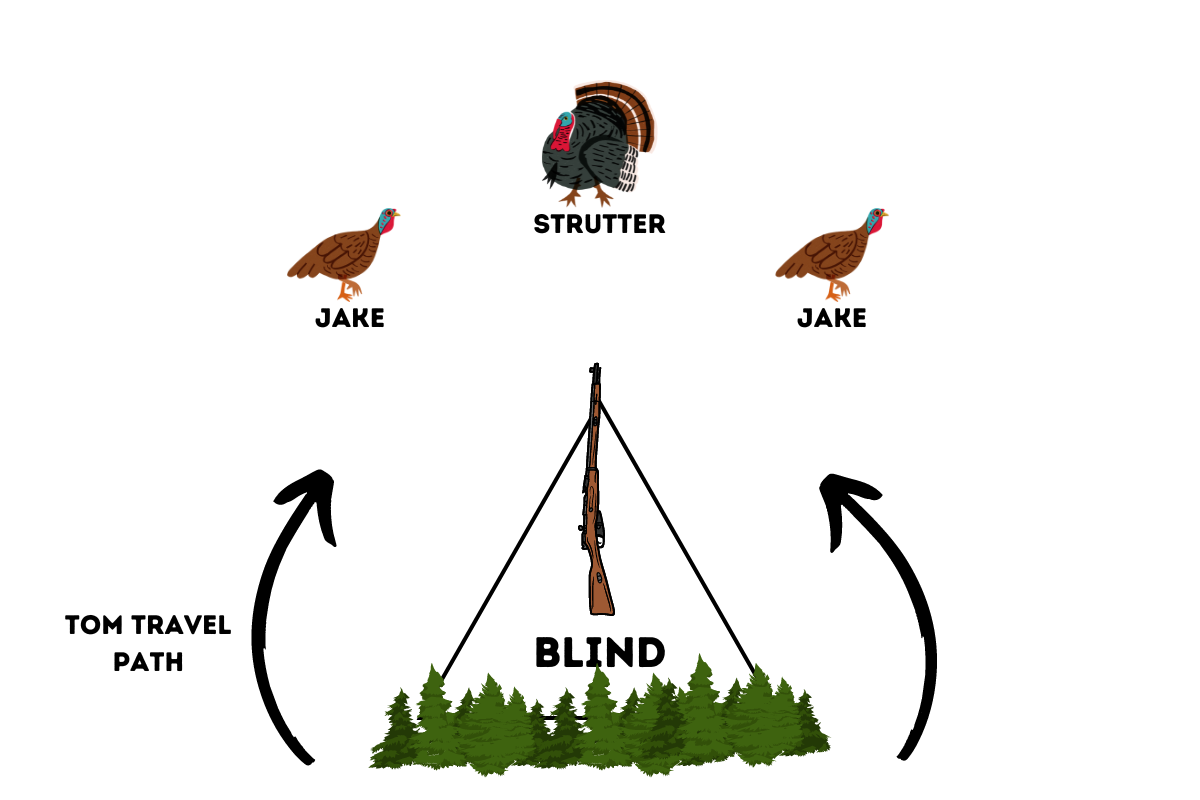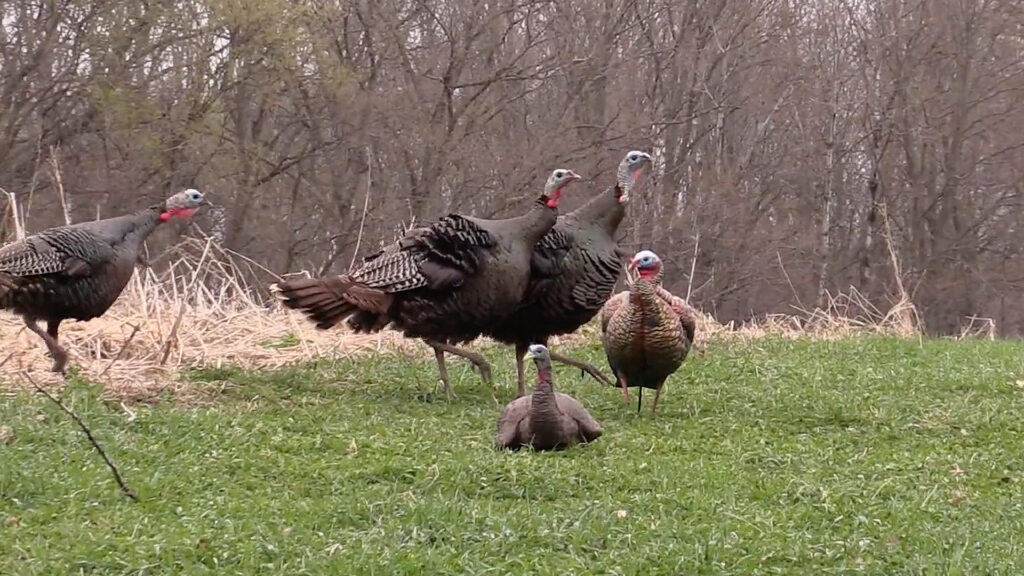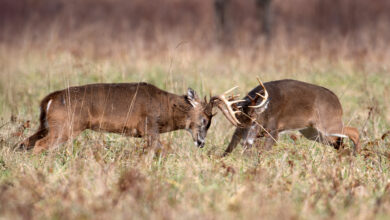Finding the Right Turkey Decoy Setup Based on the Season

I have to admit, it’s tough to avoid the sharp eyesight of the turkey. That makes turkey hunting decoys super useful because of their distraction component. While the tom is focused on the decoy, he is less likely to notice any small movements that a hunter makes.
Keep in mind that the correct use of decoys is closely related to turkey mating season dynamics. To understand how to best use a turkey decoy setup we will discuss the following,
- Various decoy arrangements
- Adapting decoy strategies to seasonal phases
- And more…
Asserting Dominance (early season)
As the season begins, the hens are not ready to breed while the gobblers are testosterone-driven and ready to establish dominance. With the rise in male anxiety, the chances of turkey fights are higher. That makes it the right time to use a strutting tom decoy to attract the bully toms.
Now is the time to set up your decoys to establish jealousy. Try placing a jake decoy a couple of yards from a hen decoy. Remember that toms will want to approach the jake decoy chest-to-chest and the hen turkey from behind.
When you know how to scout for turkeys, you should be able to find the best spots for setting up the decoys. You can use multiple hen decoys with the strutting tom if needed. If a strutting tom is unavailable, try using a Jake decoy. However, this period lasts for around two weeks. Once the pecking order is established, the toms who have lost a few fights will avoid the full strut tom.
Note, that winter turkey flocks have just broken up and the hens have spent the last few months together. So, setting up a lone hen decoy in this phase is not the best idea as it might stand out as a stranger.
Once the bird is close, give it time. Make sure it is within your killing zone. Then allow the tom to engage with the decoy, and wait for a clear shot.
The Quest for Hens (mid-season)
A lone hen is an effective option that can be used in the better part of the season as it fuels the mating drive of the tom. In my experience, it is best used in mid-season when the pecking order is set. The lone hen decoy in open spaces works well for hormone-driven toms looking for a mate.
By mid-season, the early hens have started to leave the flock to look for a nesting site. Toms might find the number of hens in their harem dropping and start looking for new ones. Also, a lone hen can appeal to a satellite tom who has lost the early season battles and is looking to avoid confrontations.
Using a small flock of hens enhances the visual appeal and is more likely to drive the tom wild with lust. The presence of a large number of hens without a gobbler in sight will also boost his confidence, and tempt him to come closer. But make sure that the flock looks natural and is not bunched up.
Dealing with Henned-Up Toms (mid to late season)
In this period, setting up a Jake decoy accompanied by hens is a good option. With relatively fewer hens available, the arrangement can get the tom fired up with jealousy. As Art Helin mentions, the tom will probably want to separate the Jake from the hen and engage in a chest-to-chest confrontation. Use this to your advantage and position the decoy accordingly.
I have seen hunters pull the trigger from 15 yards when the turkey is moving or turning his head, and miss. Instead of hurrying to make the shot, be patient and hold on to the trigger till the bird is standing still. I prefer to wait till I can clearly see the turkey’s neck or head. The chances of hitting the target are much higher when there are no obstructions between me and the bird.
The Final Search (late season)
In late season, toms are not so eager to fight. A few of them are wary because of the early season butt-whipping they have received or an encounter with hunters. In areas with high hunting pressure, I prefer a conservative approach during the late season and start with roosting a turkey.
This is a period where you can use a solo hen, or a Jake decoy over a resting hen. Since the Jake is an easy target for a mature gobbler, this is a combination that can attract an older tom. Combine proper decoy placement with calling, but make sure not to overdo it.
Having a boss gobbler moving suspiciously just beyond the shooting range is frustrating. I use a range finder while positioning the decoys to make sure that the area where I will be shooting is within my killing zone.
Tips from Own the Season Cameraman Derrick Warner: Never stop learning. Pay attention. Soak everything you see and hear like a sponge, and apply it to your hunt. Get as close to the roost as you can, as quietly as you can. Practice soft calling.
Turkey Decoy Setup Diagram

Tailoring Decoy Setups to Different Environments
Setting up turkey decoys depends not only on the season but also on the terrain. Take a look.
Wide Open Spaces and Fields
While setting decoys in open spaces, remember, that foliage has grown in late season. So, the tom might find the decoys like a a resting hen difficult to see. When the grass is thick, think of placing the decoy on a rise where it is better visible. We tend to forget that turkeys are not as tall as us. Get down to their level and check the decoy position. Think of setting up multiple decoys to improve visibility.
If you are depending on calling, a clearly visible decoy will help in completing the visual equation for the turkey. Once he has heard and seen a hen, the gobbler is more likely to approach it.
Wooded Areas, Trails, and Logging Roads
Since turkeys follow predictable pathways or a path of least resistance in heavily wooded areas, you can use the terrain to your advantage. For example, they prefer following logging roads and ridgetops. Avoid placing decoys in areas with lots of visual obstruction like mature woods. Placing the decoy on top of a wooded ridge or the side of a logging road makes more sense.
The choice of decoy will depend on the season. Using a hen and Jake decoy duo or a solo hen decoy are good options. While using multiple decoys, spread the decoys around to draw the gobbler and give him enough space to do his thing.
This will also help you to get a clear shot. Make sure to offset the position of the decoy rather than placing it directly in front of you. That way, they are less likely to notice your movements.

How Many Turkey Decoys to Use?
There is no one-size-fits-all approach to choosing the number of decoys. For creating a flock, using four to five decoys should be good enough. Otherwise, stick to a solo decoy or a two-decoy combination.
While the feeder hen is my favorite decoy, I hardly use more than two to three decoys. However, it all depends on multiple variables including the time of the season. Not every decoy setup will deliver results. Even if everything looks good to you, it may not look the same for the turkey.
Final Thoughts
Turkey decoys work best when you put some thought into the setup. Depending on the conditions, you need to decide whether to use a decoy or not. Take your time with the setup and if it is not working, move to a new plan.
Lastly, make sure you stay cautious at every stage of using a turkey decoy setup. Remain aware of your surroundings and make sure that the decoys do not draw fire from other hunters.
Once you know the best turkey decoy setup to use, let the fun begin.


One Comment